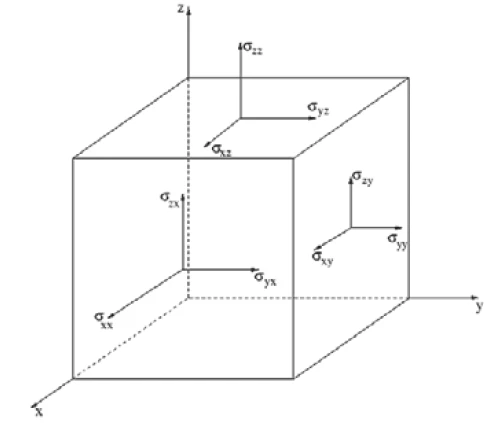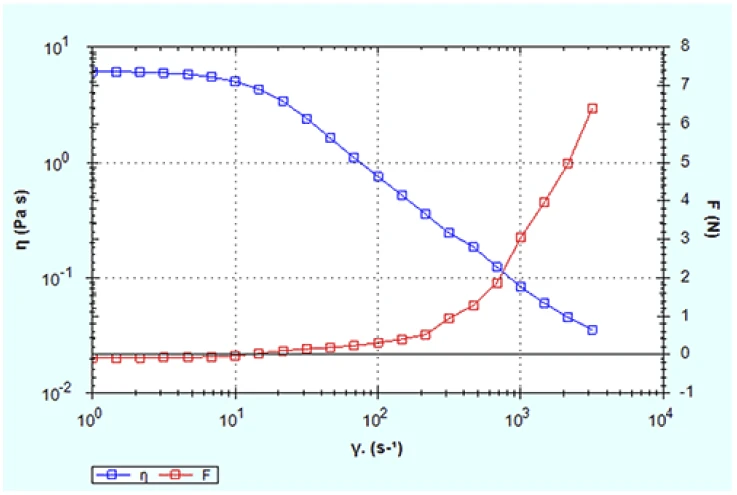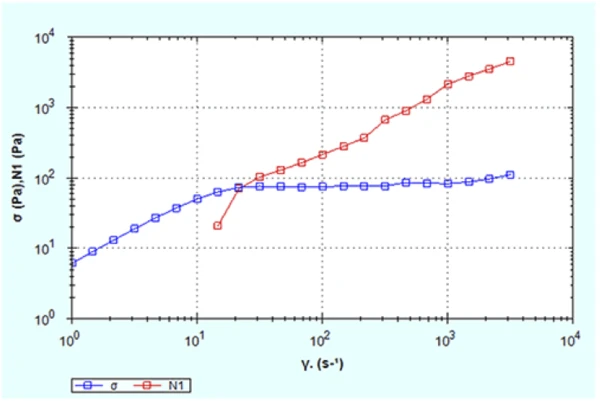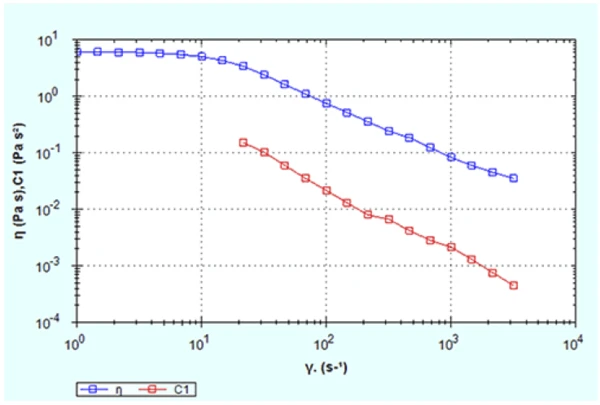Introduction
When viscoelastic materials are deformed, they undergo a three dimensional deformation, which can be described through a (3x3) tensor (see Figure 1).

The tensor contains three normal stresses, σxx, σyy, σzz. The other six tensors are shear stresses. If the viscous behavior dominates (i.e., if the fluid flows), then there is only one shear StressStress is defined as a level of force applied on a sample with a well-defined cross section. (Stress = force/area). Samples having a circular or rectangular cross section can be compressed or stretched. Elastic materials like rubber can be stretched up to 5 to 10 times their original length.stress component and the others can be ignored.
The first normal StressStress is defined as a level of force applied on a sample with a well-defined cross section. (Stress = force/area). Samples having a circular or rectangular cross section can be compressed or stretched. Elastic materials like rubber can be stretched up to 5 to 10 times their original length.stress difference can be defined as:

Where σxx is the StressStress is defined as a level of force applied on a sample with a well-defined cross section. (Stress = force/area). Samples having a circular or rectangular cross section can be compressed or stretched. Elastic materials like rubber can be stretched up to 5 to 10 times their original length.stress acting in the direction of applied shear and σyy is the StressStress is defined as a level of force applied on a sample with a well-defined cross section. (Stress = force/area). Samples having a circular or rectangular cross section can be compressed or stretched. Elastic materials like rubber can be stretched up to 5 to 10 times their original length.stress acting in the normal force direction. In a rheological experiment, the upward thrust on the geometry and the bearing is the normal force (which is in the axial direction). The normal StressStress is defined as a level of force applied on a sample with a well-defined cross section. (Stress = force/area). Samples having a circular or rectangular cross section can be compressed or stretched. Elastic materials like rubber can be stretched up to 5 to 10 times their original length.stress differences are usually more shear rate dependent then the shear StressStress is defined as a level of force applied on a sample with a well-defined cross section. (Stress = force/area). Samples having a circular or rectangular cross section can be compressed or stretched. Elastic materials like rubber can be stretched up to 5 to 10 times their original length.stress and can show significant increases with increasing shear rate.
In addition to N1 we can also define the first normal StressStress is defined as a level of force applied on a sample with a well-defined cross section. (Stress = force/area). Samples having a circular or rectangular cross section can be compressed or stretched. Elastic materials like rubber can be stretched up to 5 to 10 times their original length.stress coefficient which can be considered a viscoelastic equivalent to viscosity and is dependent on shear rate ý according to the following equation.

Normal StressStress is defined as a level of force applied on a sample with a well-defined cross section. (Stress = force/area). Samples having a circular or rectangular cross section can be compressed or stretched. Elastic materials like rubber can be stretched up to 5 to 10 times their original length.stress differences are associated with non-linear effects and are a result of the underlying microstructure becoming anisotropic under the flow conditions. Normal rheological effects such as the Weissenberg or ‘rodclimbing’ effect, the ‘die-swell’ or ‘post-extrusion swell’ effect, etc.
A large range of products, including polymer melts, solutions, surfactant systems and emulsions can exhibit normal stresses. In the majority of cases, normal stresses are positive, but negative normal stresses have also been reported in some instances, e.g., in lamellar gels.
The best geometry to use for correctly measuring the first normal StressStress is defined as a level of force applied on a sample with a well-defined cross section. (Stress = force/area). Samples having a circular or rectangular cross section can be compressed or stretched. Elastic materials like rubber can be stretched up to 5 to 10 times their original length.stress difference is the cone and plate geometry because it offers a consistent shear rate across the sample and upward thrust is due to N1 only.
Experimental
- The non-linear visco-elastic behavior of a body wash was evaluated.
- Rotational rheometer measurements were made using a Kinexus rheometer with a Peltier plate cartridge and using cone-plate measuring system1, and using standard pre-configured sequences in the rSpace software.
- A standard loading sequence was used to ensure that both samples were subject to a consistent and controllable loading protocol.
- All rheology measurements were performed at 25°C.
- The flow curve was generated using an equilibrium table of shear rates test between 0.1 and 1000 s-1 and the normal force determined.
Results and Discussion
Figure 2 shows the viscosity-shear rate curve for the body wash. This product can be classed as a Shear ThinningThe most common type of non-Newtonian behavior is shear thinning or pseudoplastic flow, where the fluid viscosity decreases with increasing shear.shear thinning liquid since it shows Newtonian behavior at low shear rates followed by rapid drop in viscosity above a critical shear rate. Above this critical rate there is also an apparent rise in the normal force resulting from non-linear viscoelastic behavior caused by tension in the deforming microstructure.

This is more apparent when the shear stresses and normal stresses are compared directly as in Figure 3. This shows that the normal StressStress is defined as a level of force applied on a sample with a well-defined cross section. (Stress = force/area). Samples having a circular or rectangular cross section can be compressed or stretched. Elastic materials like rubber can be stretched up to 5 to 10 times their original length.stress surpasses the shear stress at the point at which the shear stress becomes constant. This corresponds with elastic dominant flow behavior and explains why surfactant structured body washes appear ‘highly elastic’ and ‘stringy’ when in use. Eventually, this elastic dominant behavior will lead to flow instabilities at high shear rates and the sample will climb out of the measurement gap.

Figure 4 shows the first normal stress coefficient ψ1 plotted alongside the shear viscosity. The two coefficients show similar forms but because ψ1 is proportional to ý[1], it is lower than η in this case and shows a steeper gradient. Comparing ψ1 or N1 as well as viscosity for viscoelastic materials can be useful, especially if the material is highly viscoelastic and the application or process the material is used in is likely to generate tension in the streamlines.

Conclusion
The non-linear viscoelastic behavior of a Non-NewtonianA non-Newtonian fluid is one that exhibits a viscosity that varies as a function of the applied shear rate or shear stress.non-Newtonian material can be determined by measuring the normal force as a function of shear rate shear rate using a cone-plate measuring system. The first normal stress difference and first normal stress coefficient which are equivalent to the shear stress and shear viscosity respectively can also be calculated.
1Please note that testing should be made wiht a cone plate measuring system.